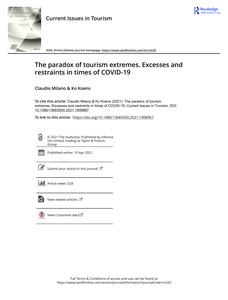Stedelijke natuurversterking is bij uitstek een thema dat door de schalen heen moet worden bekeken. Van pocket park en gevelbekleding tot stedelijke groenstructuur, de biodiversiteit komt het beste tot bloei door samenhang.In het SIA-project Natuurinclusieve Gebiedsontwikkeling onderzochten vier hogescholen - Aeres Hogeschool, Avans Hogeschool, Hogeschool van Amsterdam en Hogeschool Van Hall Larenstein - drie schaalniveaus van gebiedsontwikkeling om de transitie naar natuurinclusieve gebiedsontwikkeling te versnellen. Gekoppeld aan drie casussen waren dit: gebouw (Spoorzone Waarder), straat (Knowledge Mile Park - KMP - Amsterdam), en gebied (Almere Centrum-Pampus). De casussen belichten veelvoorkomende typen ingrepen, zoals kleinschalige nieuwbouw, verbetering van de publieke ruimte, en binnenstedelijke woningbouw. Ondanks dat elke case een eigen thematisch zwaartepunt had - biobased materialen (Spoorzone Waarder), natuurlijke vergroening (KMP), en governance (Almere) - heeft via deelonderzoeken en tussen hogescholen kruisbestuiving plaatsgevonden. De white paper geeft de belangrijkste resultaten en lessen hiervan weer.Urban nature enhancement is a theme that needs to be considered across different scale levels. From pocket parks and façade greening to urban green infrastructure, biodiversity thrives best through connectivity.In the SIA-project Nature-inclusive Area Development, four universities of applied sciences - Aeres University of Applied Sciences, Avans UAS, Amsterdam UAS, and Van Hall Larenstein UAS- researched three scale levels of area development to accelerate the transition to nature-inclusive area development. This was linked to three case studies: Waarder Railway Zone (building), Knowledge Mile Park (KMP - street - Amsterdam), and Almere Centre-Pampus (area). The case studies represent common types of urban interventions, such as small-scale new developments, improvement of public space, and inner-city densification. Despite each case having its own thematic focus - biobased materials (Waarder Railway Zone), natural greening (KMP), and governance (Almere) - cross-pollination took place through sub-studies and collaboration between universities. The following pages present the main results and lessons learnt.
MULTIFILE

This paper seeks to highlight underlying issues of the tourism system that have led to tourism extremes of too much or too little tourism. Five phases are recognized that reflect different ways of dealing with too much tourism over time, after which the impact of a sudden lack of tourism is investigated in light of future renewal processes. This discussion highlights the remarkable capacity of the tourism industry to adjust to rapidly changing circumstances and crises, even when these cause anguish to individuals and within societies at large. The paper thus seeks to contextualize the current discussions regarding the transformation of tourism post COVID-19. It highlights the complexity of changing a tourism that multiple stakeholders depend on or have grown accustomed to. To come to a more balanced tourism, it is necessary to not only come up with alternative visions and strategies, but also to engage with the political economy nature of tourism development. A future research agenda should therefore also discuss facets of entangled power, social exclusion, inequalities and class differences to come to new reference points of what actually constitutes a more inclusive tourism success.
MULTIFILE

This paper essentially presents an exploration of the relationship between organizational culture and information systems management. Three contributions are offered namely the findings of a study of the organizational culture and information management competencies of five organizations in the Netherlands, with particular reference to the reliability of the measurements tool that was used, as well as an exploratory study of the relationship between organizational culture and the ability of an organization to manage its information systems. A brief review of the literature reveals that these two concepts in combination have been studied extensively, but that their conceptualization are somewhat fragmented in nature. In an effort to study the relationship using a more inclusive frame of reference the paper then presents a description of two models that were used the foundation for the design of a measurement tool to investigate the topic. The results provides a description of the general culture and information systems management abilities of the organizations and also suggest that the measurement tool is indeed reliable. Further analysis reveals that several variables from within each of the two main concepts, organizational culture and information systems management, are correlated.
DOCUMENT

In the Netherlands, the theme of transitioning to circular food systems is high on the national agenda. The PBL Netherlands Environmental Assessment Agency has stressed that commuting to circular food chains requires a radical transformation of the food chain where (a) natural resources must be effectively used and managed (soil, water, biodiversity, minerals), (b) there must be an optimum use of food by reducing (food) waste . . ., (c) less environmental pressure, and (d) an optimum use of residue streams. The PBL also recognizes that there should be room for tailored solutions and that it is important to establish a benchmark, to be aware of impacts in the production chain and the added value of products. In the line of circular food systems, an integrated nature-inclusive circular farming approach is needed in order to develop a feasible resource-efficient and sustainable business models that brings shared value into the food chain while invigorating the rural areas including those where agricultural vacancy is occurring. Agroforestry is an example of an integrated nature-inclusive circular farming. It is a multifunctional system that diversifies and adapts the production while reducing the carbon footprint and minimizing the management efforts and input costs; where trees, crops and/or livestock open business opportunities in the food value chains as well as in the waste stream chains. To exploit the opportunities that agroforestry as an integrated resource-efficient farming system adds to the advancement towards (a) valuable circular short food chains, (b) nature-based entrepreneurship (nature-inclusive agriculture), and (c) and additionally, the re-use of abandoned agricultural spaces in the Overijssel province, this project mobilizes the private sector, provincial decision makers, financers and knowledge institutes into developing insights over the feasible implementation of agroforestry systems that can bring economic profit while enhancing and maintaining ecosystem services.